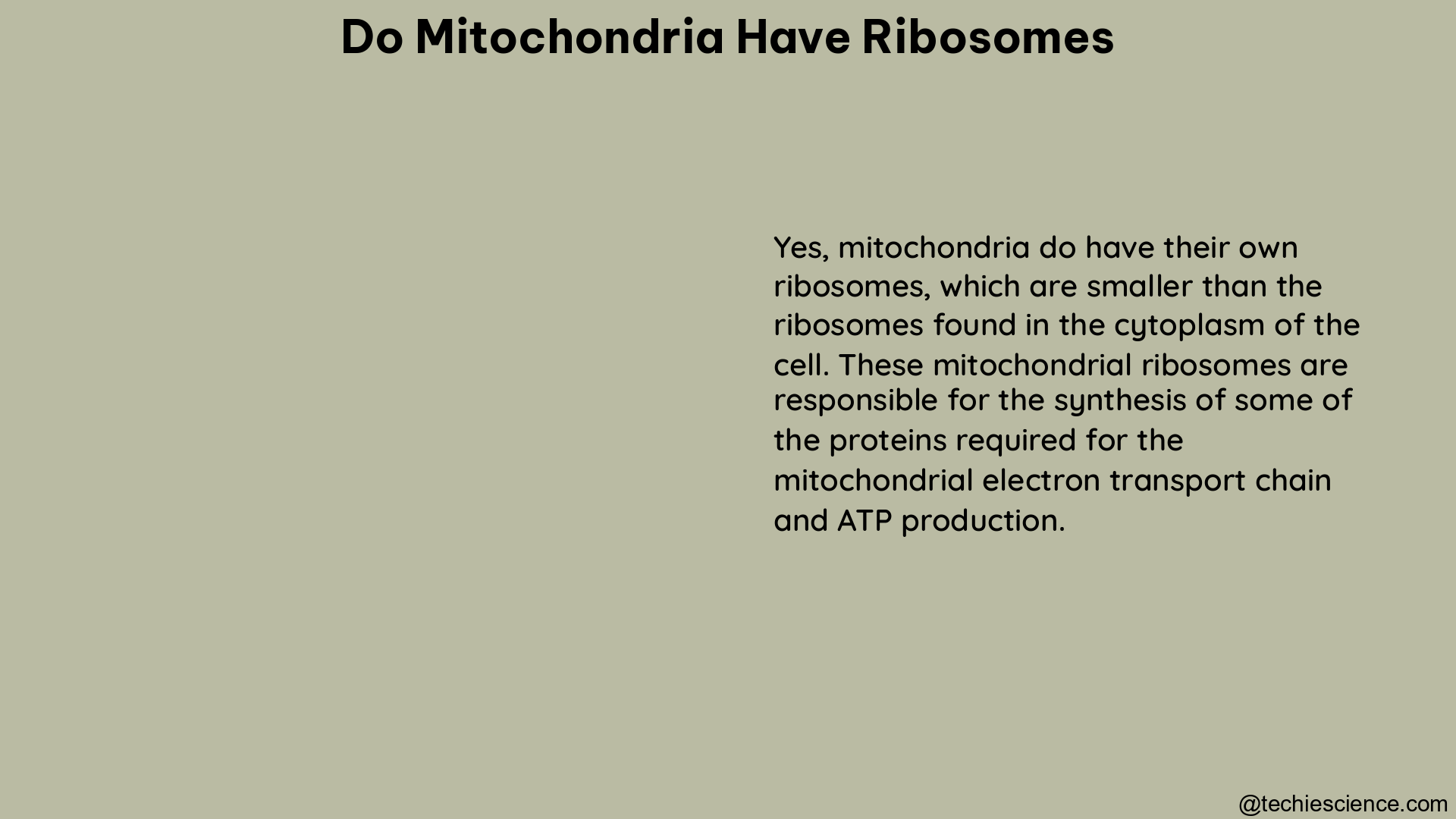Mitochondria, the powerhouses of eukaryotic cells, are not just simple organelles; they possess their own genetic material and machinery for protein synthesis, including ribosomes. These specialized ribosomes, known as mitochondrial ribosomes (mitoribosomes), play a crucial role in the overall function and health of the cell.
The Importance of Mitoribosomes
Mitoribosomes are essential for the translation of mitochondrial mRNAs into proteins, which are necessary for the proper functioning of the mitochondrial respiratory chain and energy production. These proteins include subunits of the electron transport chain complexes, as well as enzymes involved in mitochondrial DNA replication, transcription, and other essential processes.
Structure and Composition of Mitoribosomes

Mitoribosomes are complex molecular machines, consisting of several RNA molecules and 60 to 80 different proteins. They have a sedimentation coefficient of about 55S and are composed of a 28S small subunit (SSU) and a 39S large subunit (LSU). Interestingly, the human mitochondrial ribosome is composed of 82 proteins, a significantly higher number compared to the 54 proteins found in bacterial ribosomes.
Mitochondrial Ribosomal Proteins (MRPs)
The assembly of mitoribosomes involves the import of several dozens of mitochondrial ribosomal proteins (MRPs), which are encoded in the nuclear genome. These MRPs are then transported into the mitochondrial matrix, where they assemble with the mitochondrial-encoded rRNA molecules to form the functional mitoribosomes.
Interestingly, not all MRPs have a conventional N-terminal mitochondrial targeting signal (MTS). In fact, up to 25% of yeast MRPs do not have a conventional MTS and instead use internal MTSs for targeting. This highlights the versatility and complexity of the mitochondrial protein targeting system.
Mitochondrial Ribosomal RNA (mt-rRNA)
In addition to the MRPs, mitoribosomes also contain mitochondrial-encoded ribosomal RNA (mt-rRNA) molecules. These mt-rRNA molecules are transcribed from the mitochondrial genome and play a crucial role in the structure and function of the mitoribosomes.
The mt-rRNA molecules in mitoribosomes are typically shorter and more compact compared to their counterparts in cytoplasmic ribosomes. This structural difference is thought to be an adaptation to the limited space within the mitochondrial matrix.
Mitoribosome Biogenesis and Dynamics
The biogenesis of mitoribosomes is a complex process that involves the coordinated expression and assembly of both nuclear-encoded and mitochondrial-encoded components. This process is tightly regulated and is essential for maintaining the overall health and function of the mitochondria.
Mitochondrial Protein Targeting and Import
As mentioned earlier, the majority of MRPs are encoded in the nuclear genome and must be imported into the mitochondrial matrix for the assembly of mitoribosomes. This process involves the recognition of mitochondrial targeting signals (MTSs) by specialized import machinery, such as the translocase of the outer membrane (TOM) and translocase of the inner membrane (TIM) complexes.
The presence of internal MTSs in a subset of MRPs highlights the versatility and complexity of the mitochondrial protein targeting system. Researchers are still working to fully understand the mechanisms and regulatory pathways involved in this process.
Mitoribosome Dynamics and Turnover
Mitoribosomes are not static structures; they undergo dynamic changes and turnover to maintain the overall homeostasis of the mitochondria. This includes the disassembly and reassembly of mitoribosomes, as well as the degradation and replacement of individual components.
The regulation of mitoribosome dynamics is crucial for the cell’s ability to respond to changes in energy demands, environmental stressors, and other factors that can impact mitochondrial function.
Mitoribosome Dysfunction and Disease
Disruptions in the structure, assembly, or function of mitoribosomes can have severe consequences for the cell and the overall health of the organism. Mitoribosome dysfunction has been linked to a broad spectrum of diseases, including neurodegenerative disorders, metabolic disorders, and various forms of cancer.
Mitochondrial Diseases
Mutations in genes encoding mitochondrial ribosomal proteins or other components involved in mitoribosome biogenesis and function can lead to mitochondrial diseases. These diseases are often characterized by impaired energy production, oxidative stress, and tissue-specific pathologies, depending on the specific genetic defect.
Examples of mitochondrial diseases associated with mitoribosome dysfunction include:
- Mitochondrial encephalomyopathy, lactic acidosis, and stroke-like episodes (MELAS)
- Myoclonic epilepsy with ragged-red fibers (MERRF)
- Leigh syndrome
- Neuropathy, ataxia, and retinitis pigmentosa (NARP)
Cancer and Mitoribosome Dysregulation
Emerging evidence suggests that mitoribosome dysfunction may also play a role in the development and progression of certain types of cancer. Alterations in the expression or function of mitochondrial ribosomal proteins have been observed in various cancer models and patient samples.
The link between mitoribosome dysregulation and cancer is an active area of research, as it may provide new insights into the metabolic reprogramming and altered energy production pathways that are often observed in cancer cells.
Conclusion
In summary, mitochondria do indeed possess their own ribosomes, known as mitoribosomes, which are essential for the translation of mitochondrial mRNAs into proteins necessary for the proper functioning of the mitochondrial respiratory chain and energy production. The assembly and function of mitoribosomes involve a complex interplay between nuclear-encoded and mitochondrially-encoded components, highlighting the versatility and importance of this organelle within the eukaryotic cell.
Understanding the structure, biogenesis, and dynamics of mitoribosomes, as well as their role in mitochondrial diseases and cancer, is an active area of research that continues to provide valuable insights into the fundamental biology of mitochondria and their impact on overall cellular health and function.
References:
– Mitochondrial Ribosomes: Structure, Function, and Dynamics
– Mitochondrial Ribosomes: Structure, Function, and Dynamics in Health and Disease
– Why Are There Ribosomes in the Mitochondria?
– Mitochondrial Ribosomes: Structure, Function, and Role in Disease
– Mitochondrial Ribosome
Hey! I am Sneha Sah, I have completed post graduation in Biotechnology. Science has always been fascinating to me and writing is my passion. As an academic writer my aim is to make Science easy and simple to learn and read.